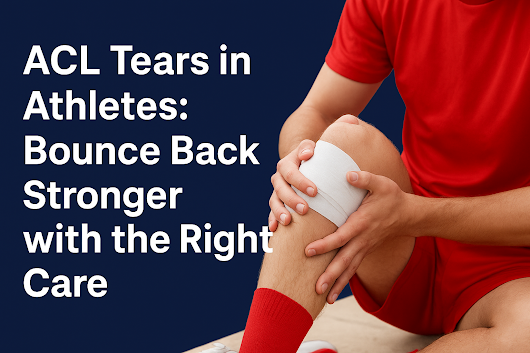Athletes push their bodies to the limit every day, testing strength, endurance, and agility. While this dedication fuels performance, it also increases the risk of sports-related injuries. Among the most common and feared injuries is the ACL tear. For athletes, an ACL tear isn’t just a physical setback—it can feel like a pause on their entire career. However, with advancements in orthopedic care, rehabilitation, and modern surgical techniques, athletes now have a greater chance than ever to bounce back stronger.
What is the ACL and Why is it Important for Athletes?
The Anterior Cruciate Ligament (ACL) is one of the four key ligaments that stabilize the knee joint. Located at the center of the knee, the ACL connects the thigh bone (femur) to the shin bone (tibia), preventing excessive forward movement and providing rotational stability.
For athletes, the ACL is critical because it supports:
- Sudden stops and pivots in sports like basketball, soccer, and tennis.
- Explosive movements such as sprinting and jumping.
- Balance and control during quick directional changes.
Common Causes of ACL Tears in Athletes
ACL tears in athletes often result from non-contact movements rather than direct trauma. Key causes include:
- Sudden deceleration while running.
- Rapid pivoting or twisting motions.
- Landing awkwardly after a jump.
- Direct impact to the knee, common in football or rugby.
- Poor conditioning or muscle imbalances around the knee joint.
Signs and Symptoms of an ACL Tear
Recognizing the early signs of an ACL tear is crucial for quick diagnosis and treatment. Athletes typically experience:
- A “popping” sound at the time of injury.
- Sudden pain and inability to continue activity.
- Rapid swelling within hours of the injury.
- A feeling of instability or “giving way” when walking or running.
- Loss of range of motion in the knee.
Diagnosing ACL Tears in Athletes
Doctors use a combination of physical exams and imaging tests to diagnose ACL injuries.
- Lachman Test / Pivot Shift Test: To check knee stability.
- MRI Scans: Provide detailed images of soft tissue damage.
- X-rays: Used to rule out associated fractures.
Early diagnosis ensures the best possible treatment plan and minimizes long-term damage to the knee.
Treatment Options for ACL Tears in Athletes
The treatment depends on the severity of the tear and the athlete’s activity level.
1. Non-Surgical Management
In some partial tears or in less active athletes, conservative treatment may be recommended:
- Rest, ice, compression, and elevation (RICE).
- Bracing for knee support.
- Physical therapy to strengthen surrounding muscles.
However, for professional and semi-professional athletes, non-surgical treatment is rarely sufficient, as the knee must withstand high physical demands.
2. Surgical Treatment – ACL Reconstruction
Most athletes with complete ACL tears undergo ACL reconstruction surgery. In this procedure, the torn ligament is replaced with a graft taken from:
- The athlete’s own body (autograft, often hamstring or patellar tendon).
- A donor (allograft).
Minimally invasive arthroscopic techniques allow faster healing, less scarring, and reduced pain compared to traditional open surgery.
Rehabilitation After ACL Surgery
Rehabilitation is the most crucial phase of recovery. The success of surgery depends heavily on a structured physiotherapy program.
Rehab Timeline for Athletes:
- Weeks 1–3: Focus on reducing swelling, restoring range of motion, and walking with support.
- Weeks 4–12: Strengthening the quadriceps, hamstrings, and hip muscles.
- Months 3–6: Gradual introduction of agility training, light running, and balance exercises.
- Months 6–9: Sport-specific drills, plyometrics, and endurance training.
- After 9 months: Return-to-sport testing before resuming competitive play.
Athletes who strictly follow their rehabilitation plan often regain full knee function and return to their sport at a high performance level.
Mental Challenges and Motivation During Recovery
Recovering from an ACL tear is not only physical but also mental. Athletes often experience:
- Anxiety about re-injury.
- Fear of not performing at the same level.
- Frustration due to the long recovery period.
Support from coaches, physiotherapists, sports psychologists, and family plays an essential role in keeping the athlete motivated throughout the journey.
Preventing ACL Tears in Athletes
Prevention programs are becoming increasingly important in sports medicine. Key strategies include:
- Strength training for quadriceps, hamstrings, and core stability.
- Neuromuscular training to improve balance and landing mechanics.
- Flexibility exercises to reduce strain on joints.
- Proper warm-up routines before training and competition.
- Wearing the right footwear for the playing surface.
Teams and sports academies that implement ACL prevention programs report significantly fewer injuries among their athletes.
Returning to Sports After ACL Tears
The ultimate goal for athletes is not just recovery but safe return to play. Doctors and physiotherapists use specific tests to assess readiness:
- Single-leg hop tests.
- Strength symmetry between legs.
- Psychological readiness questionnaires.
Athletes are advised not to rush this stage, as returning too early increases the risk of re-injury.
Long-Term Outlook for Athletes After ACL Tears
With proper care, most athletes can return to their sport within 9–12 months. However, long-term risks include:
- Higher chances of developing knee osteoarthritis.
- Re-injury if the knee isn’t fully rehabilitated.
- Need for lifestyle modifications in high-impact sports.
That said, advances in orthopedic surgery and rehabilitation have made outcomes more promising than ever before. Many elite athletes, including footballers, basketball players, and cricketers, have returned to professional sports after successful ACL reconstruction.

